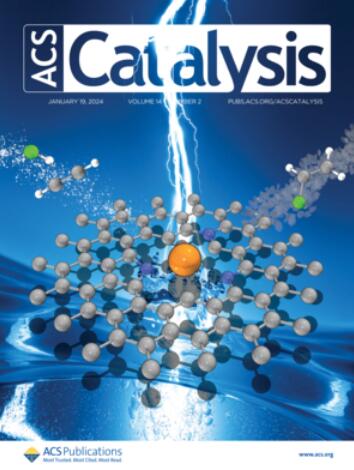阐明Cu(111)表面CO2加氢合成甲醇的机理:来自精确双杂化密度泛函的见解
IF 11.3
1区 化学
Q1 CHEMISTRY, PHYSICAL
引用次数: 0
摘要
铜基催化剂上CO2加氢合成甲醇是一种新兴的工业工艺,在化工生产中具有越来越重要的意义。然而,对反应机制的阐明和活性位点的鉴定仍然是持续争论的主题。由于实验方面的挑战,仅靠实验是不足以提供能源格局的完整图景的。同时,所提出的反应机理往往依赖于密度泛函理论在广义梯度近似(GGA)水平上的计算,这可能会引入相当大的不确定性。本文采用一种先进的杂化方法,XYG3:GGA,将双杂化XYG3官能团与周期性GGA相结合,研究了Cu(111)表面甲醇的合成。这种混合方法得到的结果与实验中可用的能量格局非常吻合,同时解决了H2COO*中间体的实验观察与HCOOH*中间体的gga预测途径之间的争议。这进一步阐明了Cu(111)位点的贡献如此微不足道,以至于它不能被认为是铜催化剂上甲醇形成的活性位点。这些发现强调了使用更精确的方法(如XYG3:GGA)来阐明反应机理和确定活性位点的重要性,从而弥合了实验与理论之间的差距。本文章由计算机程序翻译,如有差异,请以英文原文为准。

Clarifying the Methanol Synthesis Mechanism via CO2 Hydrogenation on the Cu(111) Surface: Insights from Accurate Doubly Hybrid Density Functionals
Methanol synthesis via CO2 hydrogenation on copper-based catalysts is an emerging industrial process that has a growing importance in chemical production. Yet, the elucidation of the reaction mechanisms and the identification of active sites remain subjects of ongoing debate. Due to experimental challenges, experiments alone are insufficient to provide a complete picture of the energy landscape. Meanwhile, the proposed reaction mechanisms often rely on density functional theory calculations at the generalized gradient approximation (GGA) level, which can introduce considerable uncertainty. Here, we employ an advanced hybrid method, XYG3:GGA, that combines the doubly hybrid XYG3 functional with the periodic GGA to investigate the methanol synthesis on the Cu(111) surface. This hybrid method yields results that align well with the available energy landscape in the experiment while resolving the controversy between the experimental observation of the H2COO* intermediate and the GGA-predicted pathway from the HCOOH* intermediate. It further clarifies that the Cu(111) site makes such an insignificant contribution that it cannot be considered the active site for the methanol formation on copper catalysts. These findings highlight the importance of using more accurate methods, such as XYG3:GGA, to elucidate the reaction mechanism and identify the active site, thereby bridging the gap between the experiment and theory.
求助全文
通过发布文献求助,成功后即可免费获取论文全文。
去求助
来源期刊

ACS Catalysis
CHEMISTRY, PHYSICAL-
CiteScore
20.80
自引率
6.20%
发文量
1253
审稿时长
1.5 months
期刊介绍:
ACS Catalysis is an esteemed journal that publishes original research in the fields of heterogeneous catalysis, molecular catalysis, and biocatalysis. It offers broad coverage across diverse areas such as life sciences, organometallics and synthesis, photochemistry and electrochemistry, drug discovery and synthesis, materials science, environmental protection, polymer discovery and synthesis, and energy and fuels.
The scope of the journal is to showcase innovative work in various aspects of catalysis. This includes new reactions and novel synthetic approaches utilizing known catalysts, the discovery or modification of new catalysts, elucidation of catalytic mechanisms through cutting-edge investigations, practical enhancements of existing processes, as well as conceptual advances in the field. Contributions to ACS Catalysis can encompass both experimental and theoretical research focused on catalytic molecules, macromolecules, and materials that exhibit catalytic turnover.
 求助内容:
求助内容: 应助结果提醒方式:
应助结果提醒方式:


